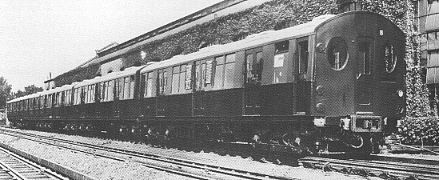
Suburban Electric Railway Association
Located at the COVENTRY ELECTRIC RAILWAY CENTRE, Rowley Road, Baginton, Warwickshire
Established
1996
The History Zone
Electrifying London
Early District Electric Stock
The District started a policy of classifying it's EMUs with a letter of the alphabet, a policy still continued today on the London Underground surface lines, letter by letter here is a guide to their EMUs from 1903 to 1935.
A Stock
Following the Earls Court experiment the District set up a full scale trial of it's intended widespread electrification equipment on the line between Mill Hill Park and South Harrow. To elevauate available EMU technology two seven car trains were ordered from Brush Traction. Each train was formed of three motor coaches and four trailers with the formation of M-T-T-M-T-T-M. The general appearance of the cars was very much in keeping with American practice with flat sided wooden bodies with clerestory roofs and gate end platforms. The motor coaches at the outer end had a luggage compartment behind the driving cab whilst the intermediate motor coaches had a driving position in a cupboard at each end which could be locked out of use when not needed. One feature that was unique to this stock was the provision of current collector shoegear on all bogies. The saloon of all vehicles had an addition set of hand operated sliding doors on each side in mid position to provide addition boarding/allighting positions to the gate ends.
The initial trials (available for general passenger traffic) took place from 23/06/1903 between Mill Hill Park and Park Royal with the run being extended to South Harrow from five days later. Following the widespread introduction of electric working on the District Line the A stock were confined to working the shuttles from South Acton to Hounslow as they were incompatible with later builds. Some of the trailers were converted to control trailers to permit the operation of two car sets. The units were withdrawn from service from this route in 1925.
B, C, D & E Stock
The B stock (pictured left) was the original mass produced EMU for the commencement of full electric services on the District which started on 13th June 1905. 420 vehicles of B stock were built to enable sixty seven car trains to be made up. 280 of the vehicles were built in France with the remainder being supplied by Brush and the Metropolitan Amalgamated Works. The style and train formation closely followed the A stock except for the replacement of the gate ends arrangement with sliding doors which were initially powered by compressed air, these proved troublesome in service and were subsequently altered to hand working. 192 of the vehicles were built as driving motor coaches with 32 control trailers and the remainder as plain trailers. The motor coaches had steel frames whilst the trailers were all timber in construction.
The C stock comprised of 32 motor coaches and 20 trailers built by Hurst Nelson in 1911 to the same basic patern as the B stock though all vehicles had steel framework and hand operated doors from new. The D stock appeared a year later and was a batch of 22 motor coaches and 8 trailers built by Metropolitan Amalgamated to the same pattern as the C stock. The first departure in styling came with the delivery in 1914 of the 26 motor coaches and 4 trailers that made up the E stock fleet as these featured eliptical rather than clerestory roofs. The B, C, D & E stock were all fully compatible with one another from new.
F Stock
The arrival of the F stock during 1920/21 signaled a radical departure from previous District units. These Met-Cam built vehicles were made entirely from steel (which earned them the nick-name Dreadnoughts). They were designed with higher performance in mind as each axle of the motor coaches was powered. The fleet was made up of 40 motor coaches, 48 trailers and 12 control trailers and they were run in eight car formations made up of a five car M-T-T-T-M and three car CT-T-M which could be detached during off peak periods. All vehicles had three pairs of hand operated sliding doors on each side. The had very distinctive oval shaped cab and body end windows.

The whole fleet were equiped with electro pneumatic brakes between 1928-30 and had their doors converted to air operation in 1938. They were transfered to the Metropolitan and East London lines in 1951 and last ran in 1963.
G Stock
These were a batch of 50 double ended motor coaches built by Gloucester Carriage & Waggon Company in 1923. There motor equipment was reclaimed from older B stock motor coaches that were converted to trailer cars (and reclassified as H stock). The saloon interior featured the usual mix of transverse and longitudinal seating. Two pairs of hand operated sliding doors were provided on each bodyside, the stylying of the G stock marked the re-appearance of the clerestory roof that had not been a feature of the E and F stock.
K Stock
101 vehicles of this type were delivered from the Birmingham Railway Carriage and Waggon Company in 1927. They were all double ended motor coaches like the G stock and differed little in internal layout from them, however their external styling was such as to give a far more rounded off appearance.
L Stock
This was a fleet of 8 motor coaches and 37 trailers built along the same style as the K stock by the Union Construction Company in 1932.M Stock
14 motor coaches and 14 trailer coaches built in 1935 by the BRC&W Co. Also a clone of the K stock design.N Stock
These were 26 trailer cars built by Met-Cam in 1935 that also copied th K stock profile.
